Cambodia
Revisited
Golden rule of Traveling
"When Years have passed, after you're first visit to a country
Don't go Back; and keep the memories of the past"
But i did break my golden rule, because my Laotian trip did include a visit to Cambodia so I got back after
5 years.
Knowing that Phnom Pehn is a major cosmopolitan city I wasn't affraid to go there, but a revisit to the monuments of Angkor
makes me worry about it. And indeed the site was overrun by tourists.
But I had made my preparations at home, so i went to a couple remote temple-sites. Even my motorcycle driver had not been there before
and had to ask the right way.
"Avoiding the tourist hubs; Siem Reap it is still an interesting place to go"
Worldtraveler55
Siem Reap
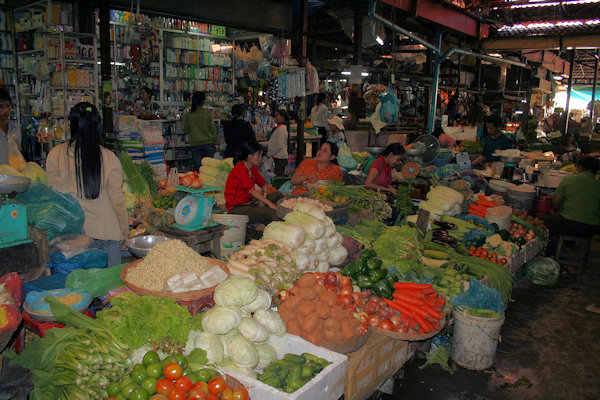 |
|||||
Siem Reap is the gateway to Cambodia's spiritual and cultural heartbeat, the temples of Angkor.
The town was a quiet, sleepy backwater about 5 years ago, when I first visit it, but it's quickly reinventing itself as a sophisticated
centre for the new wave of visitors passing through each year.
If Cambodia is hot right now, then Siem Reap is at boiling over, the one place everyone coming to Cambodia wil hit during their visit.
New Hotels and guesthouses going up every month; new restaurants and bars open every week. Tourism is now the lifehood of Siem Reap and
without careful management it could become "Siem Reapolinos", the not so Costa-del-Culture of Southeast Asia.
So if you want to go, do it now, course it will get worse every day when you delay.
These are some pictures off the old market.
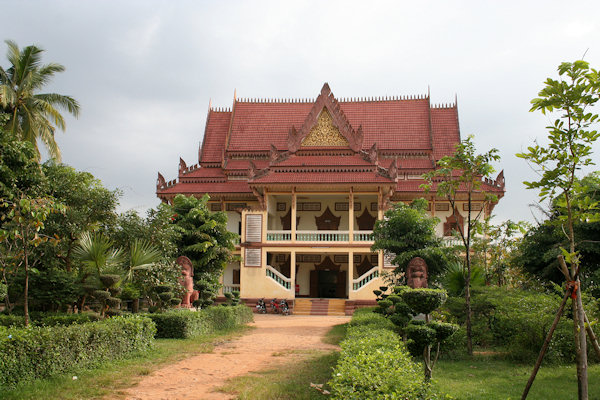 |
|||||
Wat Bo
Wat Bo Pagoda is one of the oldest pagodas in Siem Reap, and has a number of well-preserved wall paintings from the 19th century.
Although it is a Buddhist temple some of the wall paintings describe the famous ancient love story of Rama and Shita,
the "strongest man" and the
Still today the royal families of the Southeast Asian countries claim to be descendants of Rama.
Anyhow, these wall paintings describe a Hindu story that is most remarkable in a Buddhist temple.
Wat Bo temple also contains a large collection of Buddha statues that you will find behind the main Buddha.
Remote Temples
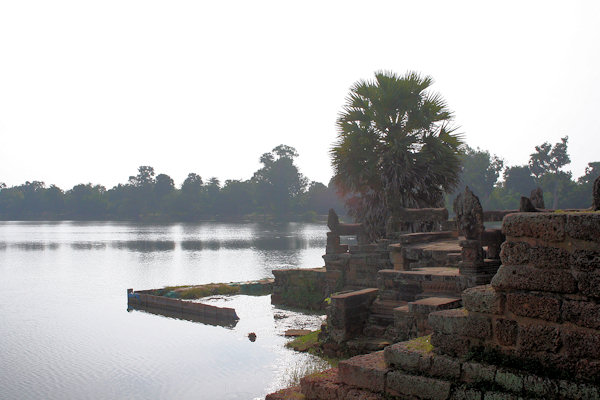 |
|||||
Srah Srang
Srah Srang is a large lake (700 by 300 metres) with an elegant landing terrace of superb proportion and scale.
It was built at the end of the 12th century by king Jayarman VII (reigned 1181 - 1220)
A majestic platform ("landing stage") with stairs to the pond is built of laterite with sandstone mouldings.
The platform is of cruciform shape with serpent balustrades flanked by two lions.
At the front there is an enormous garuda riding a three-headed serpent.
At the back there is a mythical creature comprising a three-headed serpent, the lower portion of a garuda and a stylised tail decorated
with small serpent heads. The body of the serpent rests on a dais supported by mythical monsters.
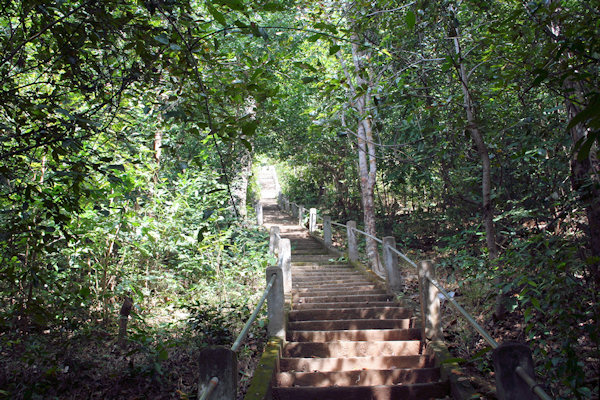 |
|||||
Phnom Bok
Phnom Bok, built by Yasovarman I in the late 9th or early 10th century is situated on top of a 212m hill and consists
of three sanctuary towers on a single terrace and four libraries facing the central towers.
The temple is dedicated to the Trimurti, the three great Hindu gods; "Shiva, Vishnu and Brahma".
The small temple is in reasonable shape and includes two frangipani trees growing out of a pair of ruinous towers. The remains of a
5m linga are also visible at the opposite end of the hill.
Avoid the heat of the middle of the day and carry plenty of water, course it's a long way up the mountain.
On top it is the views of the plains of Angkor that make it all worth.
Phnom Bok is about 25 km northeast from Siem Reap. It is accessible by continuing east on the road to Banteay Samré for about 6 km.
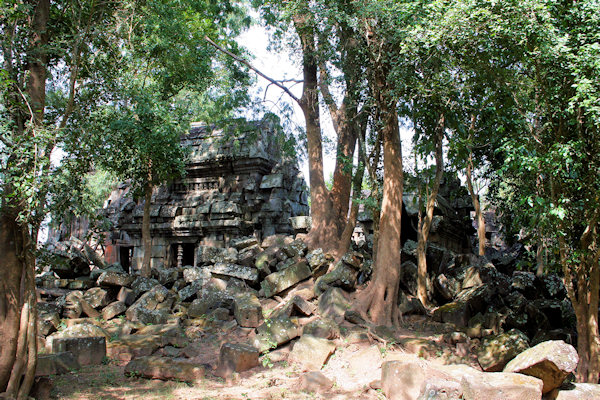 |
|||||
Chau Srei Vibol
Construction of the temple probably to the reign of Suryavarman I
(r. 1002-1049) The only surviving structures, apart from the inner sanctuary and the perimeter walls, are a laterite-lined reservoir
to the southwest and a curious cruciform-shaped building to the south.
The central sanctury is in a ruined stat, but is nicely complemented by the construction of a modern wat nearby.
surrounding the base of the hill are laterite walls, each with a small entrance hall in reasonable condition.
To get here turn east off the dirt road between Phnom Bok and Rolous at about halfway.
The route is easy to lose, so keep asking locals for directions at junctions and eventually you will find yourself in a monastic
compound at the base of a small hill.
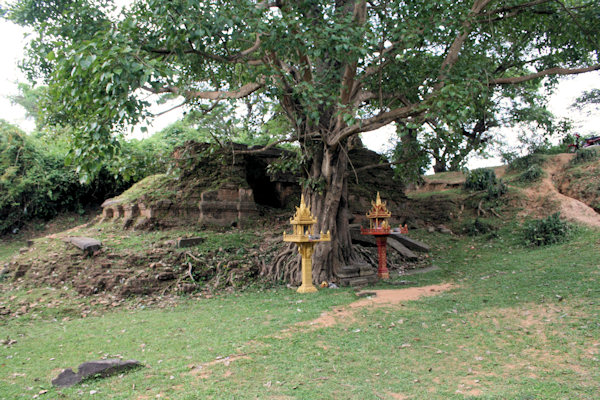 |
|||||
Ak Yum
Ak Yum is a recently cleared site and is of great historical importance because it is the earliest site in the area. Dating from the
seventh century it belongs to the pre-Angkor period.
Ak Yum was built on three levels standing on a platform and enclosed by a brick wall. The monument was built of brick with sandstone bays.
Four shrines occupied the corners of the second tier and two others stood on each side, making a total of twelve shrines.
Today less remained, but you can visit it combining with a look at the Western Baray.
Western Baray
The Western Baray, measuring an incredible 8 km by 2.3 km was excavated by hand to provide water for the intensive cultivation of lands
around Angkor. The baray was probably constructed in the 11th century by Udayadityavarman I (reign 1049 - 1065).
Kampong Khleang
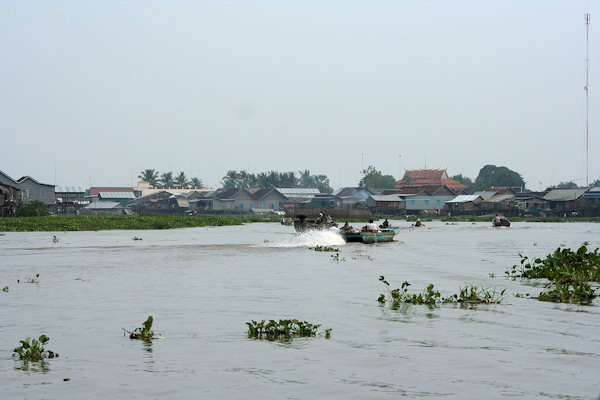 |
|||||
While in the dry season the Tonle Sap lake "only" streches for approximately 150 km in length and average round 20 km in width, at
the peak of the wet season the lake can expand to 250 km long and in places more than 100 km wide.
One of the most common adaptations to life on the lake is the "floating village".
Wooden houses are built upon great mats of bamboo, metal drums or boat hulls, such that the front veranda floats a metre or so above the
water. As the lake rises and falls so do the houses.
As well as the floating villages, there are also "stilted villages" along the banks of Tonle Sap Lake, where houses and buildings
rest on tall, thin stilts that keep the occupants dry during the wet season, with giant ladders to reach the lower levels during the
dry season.
Otherwise life in a floating village is much the same as in any Cambodian community. The only difference is that the street is made of
water and people travel by canoe or motor boat rather than bicycle or motorcycle.
Phnom Penh
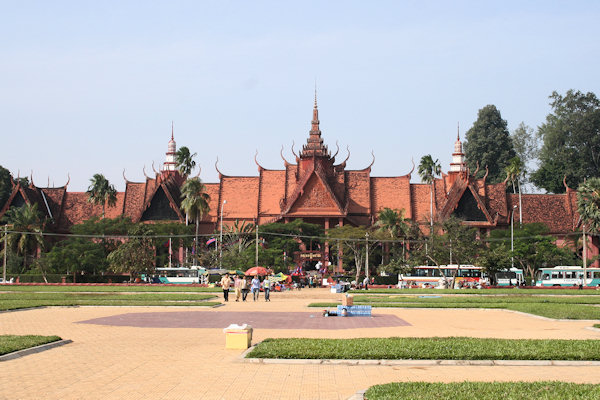 |
|||||
The National Museum of Cambodia is housed in a graceful terracotta structure of traditional design (built 1917-1920).
The museum comprises four courtyards, which face a garden.
Wat Ounalom is the headquarters of the Cambodian Buddhist Patriarchate. It was ounded in 1443 and comprises 44 structures.
The wat received a battering during the Pol Pot era, but today it has come back to life. The head of the country’s Buddhist brotherhood
lives here, along with a large number of monks.
Wat Moha Montrei was named in honour of one of King Monivong’s ministers, Chakrue Ponn, who initiated the founding of the
pagoda (moha montrei means "the great minister"). The cement "vihara" (temple sanctuary), topped with a 35m-high tower,
was completed in 1970.
The Independence Monument was built in 1958. It is also a memorial to Cambodia's war dead and is sometimes known as the
Victory Munument. Wreaths are laid here on national holidays.
Nearby is the Cambodia-Vietnam Friendship Monument, built to a Vietnamese design in 1979.
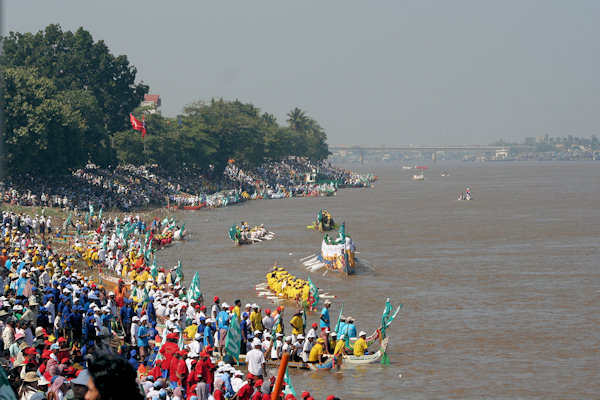 |
|||||
One off the biggest and most important annual event is the water festival Bon Om Tuk.
It celebrates a major natural occurrence: the reversing flow between the Tonle Sap and the Mekong River.
For most of the year, the Tonle Sap empties into the Mekong River. However, when the rainy season arrives in June, the Mekong rises,
reversing the flow to dump water into the lake, increasing its size ten-fold. When the rainy season ends in November, the Mekong drops
once more, allowing the current to reverse again, emptying the excess waters of Tonle Sap back into the Mekong.
This natural occurrence is celebrated in Cambodia with three days of festivals, fluvial parades, boat races, fireworks, and
general merriment.
Today, for three days every year, the population of Phnom Pehn swells as tens of thousands of people travel to the capital, sleeping
on the streets, camping in makeshift shelters or living on boats, to take part of the festivities.